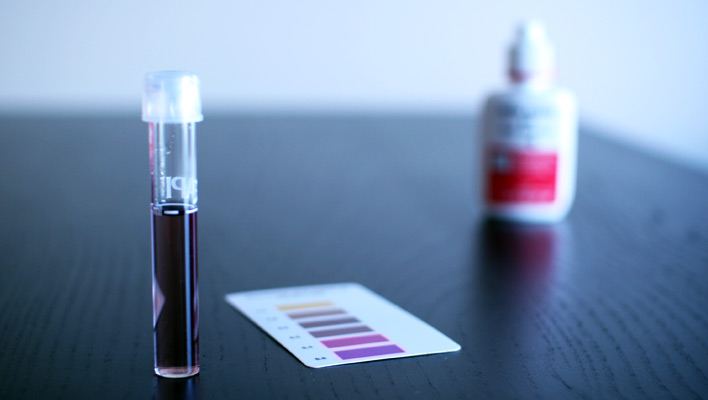One of the many important water parameters marine aquarium hobbyists must routinely monitor is pH. But what exactly is pH, what should the level be in a saltwater aquarium, what does an incorrect pH level tell us, and what’s the point of testing for it anyway?
As we mention in our post titled “Putting Aquarium Water Parameters to the Test,” pH is a measure of the hydrogen ion concentration in your system’s water, using a logarithmic scale that ranges from 0 to 14—with 7 being neutral, readings above 7 being more basic (or more “alkaline”), and readings below 7 being more acidic. The higher the hydrogen ion concentration, the lower the pH.
The scale being logarithmic means that each point on the scale is 10 times more acidic or basic (depending on which direction you move along the scale) than the preceding point. So, a pH of 6 is 10 times more acidic than a pH of 7, while a pH of 5 is 100 times more acidic than 7.
What should your aquarium’s pH reading be?
The ideal pH range for marine livestock is between 8.2 and 8.4. However, that doesn’t mean a reading outside this range is cause for alarm. It’s more important to achieve a stable pH, even if the value is somewhat lower or higher than the ideal, than to have it bouncing around.
Also, keep in mind that it’s normal for the pH to be slightly higher in the daytime than it is at night, owing to the natural photosynthetic activity of algae in the system. During the day, the algae take up carbon dioxide and produce oxygen, but this process reverses after dark—with the algae taking up oxygen and producing carbon dioxide, which is acidic and tends to lower pH.
What causes pH to plummet?
Natural biological processes in an aquarium system tend to cause the pH to shift downward gradually. There are also several factors that can cause a more rapid—or even precipitous—drop in pH. They include:
- Low alkalinity: Also called “buffering capacity,” alkalinity refers to the ability of the water to resist a downward trend in pH in the presence of an acid. When alkalinity is low, it means that there aren’t enough buffering compounds (i.e., carbonates and bicarbonates) in the water to neutralize the acids that are present. Your alkalinity level should be maintained somewhere between 8 and 12 dKH. Again, maintaining stable alkalinity is more important than achieving a precise value.
- Overstocking/overfeeding: Even if your system’s alkalinity level is appropriately high, an excessive bioload can quickly use up the available buffers and cause the pH to drop.
- Neglected maintenance: Water changes and other aspects of routine maintenance help export dissolved waste products and accumulated detritus that would otherwise decompose in the system and ultimately drive pH down. Water changes also replenish the buffering compounds that resist this change.
- Inadequate aeration: Carbon dioxide can build up and cause pH to plummet in systems with inadequate water movement and gas exchange.
How often should I test my aquarium’s pH?
We recommend testing the pH of your water on at least a weekly basis. This is very easily done with a simple liquid test kit or electronic pH probe. If you monitor this parameter on a routine basis, you’ll be more likely to detect a trend in the wrong direction relatively early when it’s easier to correct. That, in turn, will help promote the pH stability that is so critical to coral reef organisms.




great post love your site keep up the good work
Thanks for the compliments, Don! Much appreciated.